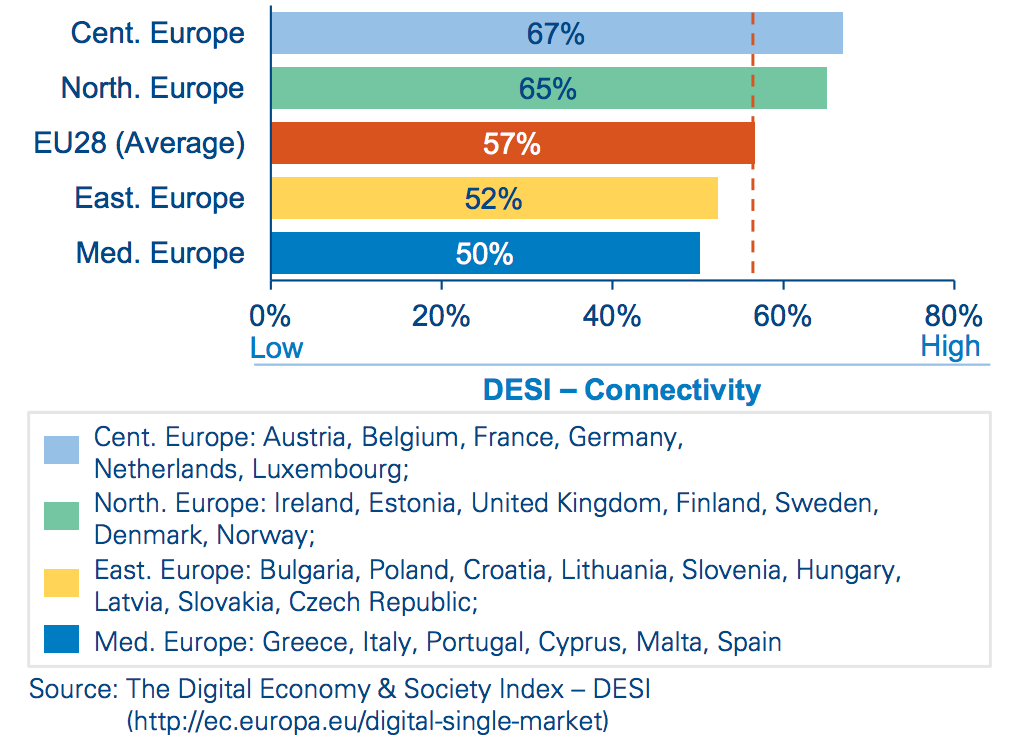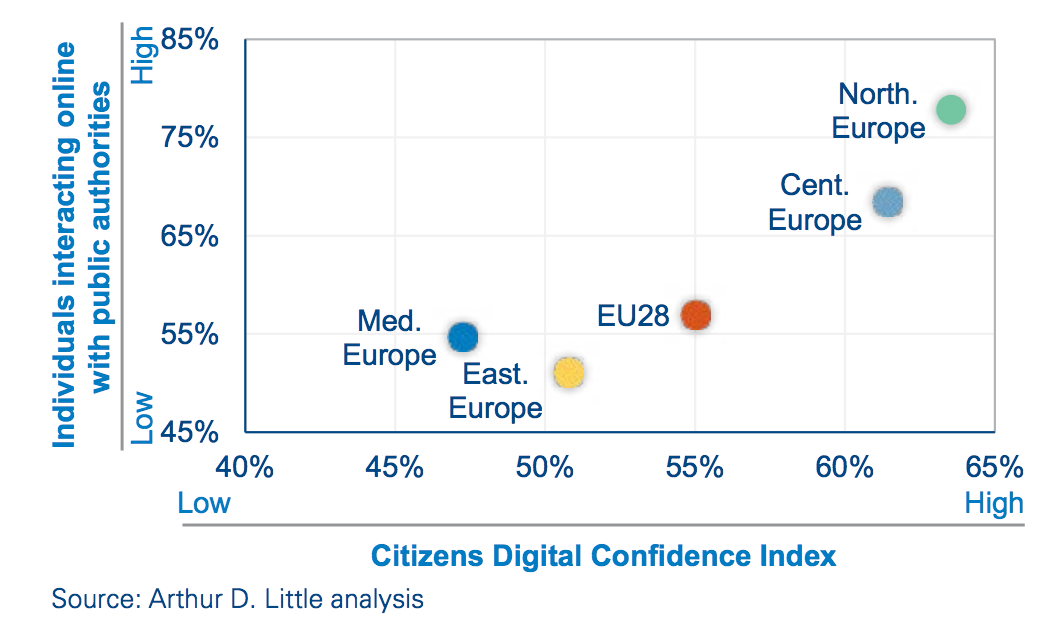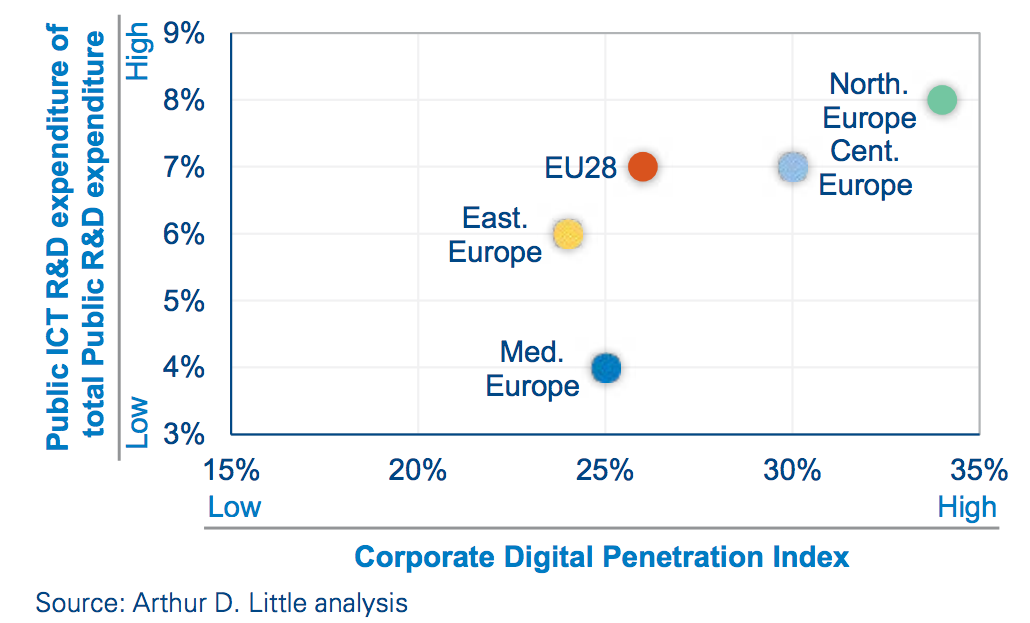
Despite investments and efforts, the performance in “connectivity” of different European regions is not homogenous. Moreover, our analysis shows two meaningful trends: first, the more confident individuals are with technology, the more they interact online with public authorities; second, the more public R&D budget is devoted to the ICT dimension, the more businesses appear positively “dominated” by technology. This means having a digital infrastructure is necessary, but not an adequate condition to succeed. European governments should focus on enhancing “digital confidence.” A Digital Competence Center represents a possible way to increase digital competences as well as public services’ “inclusion” in peoples’ lives and businesses’ operations.
The European Landscape
Enhancing digital literacy is one of the priority issues that European public administrations are addressing. Despite their investments and efforts, some European governments are still far from reaching their objectives.
Relevant EU Initiatives for Enhancing Digitalization
- eGovernment Action Plan 2016–2020: This will modernize digital public services, enabling people to get the full benefits from digital public services that should be available seamlessly across the EU
- Horizon 2020: This promises more breakthroughs, discoveries and world “firsts” by taking great ideas from the lab to the market
- The fourth industrial revolution (Industry 4.0): This aims to leverage differences between the physical, digital and biological sphere, and integrate cyber-physical systems, the Internet of Things, big data and so on
The actual question is this: “Is Europe ready to embrace digital?” The answer is not as simple as it seems; in fact, there are many variables to take into consideration. The first is the presence of digital infrastructures. Focusing on the DESI index on “Connectivity” (i.e. deployment of broadband infrastructure and its quality level), the performance of different European regions is not homogenous.

However, the deployment of digital infrastructure is just one piece of the entire puzzle. To have a better understanding of Europe’s digital landscape, Arthur D. Little has developed two aggregate indicators:
- Citizen Digital Confidence Index (CDCI) : measure of citizens’ familiarity and confidence with technology
- Corporate Digital Penetration Index (CDPI) : measure of how much technology positively dominates businesses
Arthur D. Little has found some interesting correlations that go beyond the infrastructure dimension.
Citizen Digital Confidence Index (CDCI)
Arthur D. Little found that the CDCI index is proportional with the ratio of individuals interacting online with public authorities.

As we see, the more confident individuals are with technology, the more they interact online with public authorities. This means having a digital infrastructure, as well as setting up public online services, is necessary, but not an adequate condition to succeed. There are other variables, such as “digital literacy,” that have to be taken into consideration.
Corporate Digital Penetration Index (CDPI)
Similar considerations also apply to businesses. Arthur D. Little found an interesting correlation between the CDPI index and the amount of public expenditure on ICT R&D.

As we see, the more public R&D budget is devoted to the ICT dimension, the more businesses appear digital and positively “dominated” by technology.
This means that to ensure a real digital transformation of businesses, it is fundamental for each country to invest in intellectual capital, especially in the ICT dimension.
Next steps: Create competences
The Arthur D. Little analysis shows two main problems. On one hand, to fill the gap in “digital connectivity,” European countries need to invest in digital infrastructures, allowing citizens and enterprises to be completely “wired.”
On the other hand, to fill the gap in “digital confidence,” European countries are called to:
- Create wide, specific and long-lasting competences in citizens
- Direct ICT public spending to the most effective R&D projects, to enhance the environment in which enterprises are immersed
But what does “digital competences” really mean?
According to the “DIGCOMP: A Framework for Developing and Understanding Digital Competence in Europe,”4 a “digital citizen” must be able to retrieve information on the internet to communicate and collaborate through digital media, and so on. This confirms that digital competences are one of the key requirements for citizens’ achievement of goals and objectives.
According to the “European e-Competence Framework 3.0”5 , there are some areas of competence that every organization should include to be defined as “digitally covered”: ability to manage IT strategy, process improvement, business change management, technology trend monitoring and so on.






